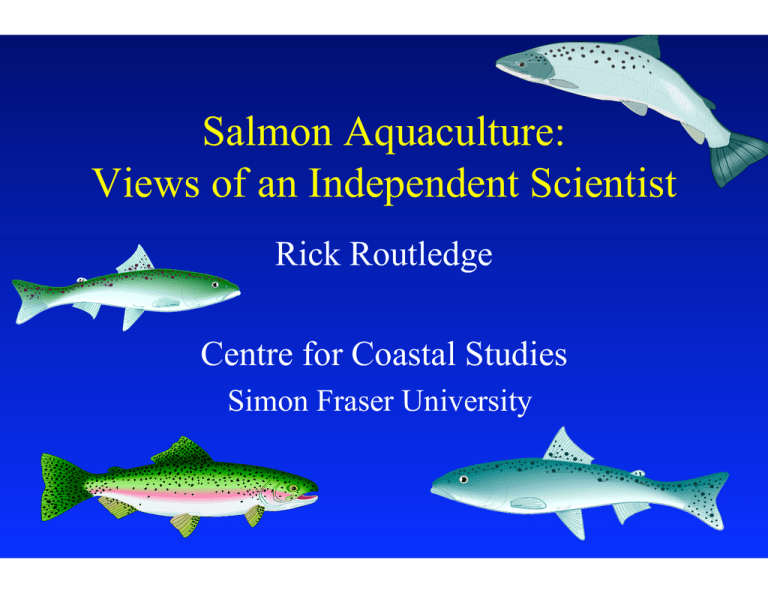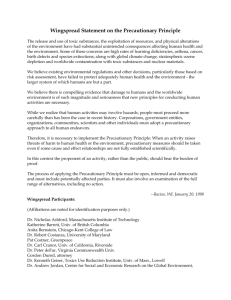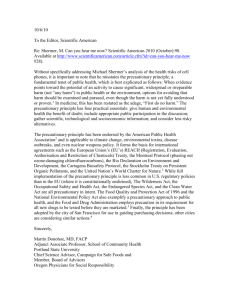Salmon Aquaculture: Views of an Independent Scientist Rick Routledge Centre for Coastal Studies
advertisement

Salmon Aquaculture: Views of an Independent Scientist Rick Routledge Centre for Coastal Studies Simon Fraser University Captain George Vancouver’s map from his 1792-94 explorations. The Precautionary Approach • Is there a reasonable chance that our present actions may cause irreversible or very long-term damage? • If so, then we need to make changes. Summary of Current Status: Sockeye • Some large stocks still faring well. • Three major stock complexes in deep trouble: • Rivers Inlet, • Early Stuart, and • Late-Run Fraser River. • Numerous small stocks faring poorly or unmonitored. B.C. Catch Statistics: 1961 • “These two areas [Rivers and Smith Inlets] produced 1,056,000 sockeye … or 23.1% of the provincial total. Area 9 [Rivers Inlet] was the second highest producing sockeye area in the province.” Rivers Inlet Sockeye Returns 3.5 3 2.5 2 1.5 1 0.5 0 Year 2000 1990 1980 1970 1960 1950 1940 1930 Escapement Catch 1920 1910 Millions of Sockeye (no escapement data prior to 1951) 1,000,000 800,000 600,000 400,000 Year 1998 1996 1994 1992 1990 1988 1986 1984 1982 - 2000 200,000 1980 Numbers of Sockeye Rivers Inlet Sockeye Escapement Estimates Summary of Current Status: Other Pacific Salmon • Coho: Thompson River and Strait of Georgia still depressed. • Chinook: Increasing concerns especially for WVCI. • Steelhead: Signs of chronic depression for many southern stocks. • Some signs of improved ocean conditions. • Global warming impacts? Simon Fraser University Meeting March, 2000 • • • • Focused on state of scientific knowledge Identified key knowledge gaps Discussed associated risks Considered relevance of Precautionary Principle Adaptive Management • The provincial government representative, in his opening remarks, stated the government’s intention to deploy adaptive management in salmon aquaculture. Three Areas of Potential Impact • Genetic Interactions • Disease Impacts • Ecological Interactions Genetic Interactions • Major impacts on interbreeding populations. • Of potential concern in B.C. for farmed chinook and coho. • Lack of knowledge of local genetic adaptations. • Critically needed in light of depletion of wild stocks and hatchery releases. Transgenic Fish • Not of interest at present, but this could change rapidly. • Critical need for stringent rules to be laid out in advance. Disease Impacts • Disease and parasite transfers between farmed and wild salmon have had serious consequences on both sides of the Atlantic. • Special concerns when wild stocks depressed. • Continuing need for tight restrictions on fish and egg importation and for disease monitoring. • Side concerns over ballast water and food importation. Disease Interactions: Related Concerns • Lack of expertise in fish diseases in government and universities. • Serious concerns over other sources of exotic species, including pathogens, especially ballast water and live food importation. Ecological Interactions Three key areas: 1. Juvenile competition with steelhead in freshwater, 2. Spawning interactions, including egg eating by precocious smolts and gamete wastage, and 3. Ocean survival of the progeny of escaped Atlantic salmon. Unavoidable Conclusion (RR) • The possibility that Atlantic salmon will successfully invade the northeastern Pacific can no longer be characterized as remote. • How large an impact might such an invasion have? Answer • It is impossible to predict the eventual outcome of the evolutionary process. • Could be as benign as the introduction of the horse. • Could be as devastating as the introduction of the sea lamprey to the Great Lakes. Precautionary Principle • General Consensus on the following: • There is sufficient lack of certainty in the potential impacts associated with salmon farming to invoke the Precautionary Principle. • Of special concern was the risk of changes to wild Pacific salmon that will be either irreversible or long-term. Questions (RR) • Who is taking responsibility for ensuring that Canada honours its international commitment to the Precautionary Principle as applied to aquaculture? • Are the management agencies in compliance with a Precautionary Approach? Is the information on which conservation and management measures are to be based uncertain, unreliable, or inadequate? No Develop measures based on this information. No need to apply a Precautionary Approach. Yes Apply a Precautionary Approach. Err on the side of caution. Measures are consistent with a Precautionary Approach. Monitor implementation and effectiveness of measures. Continue to gather relevant information. Yes to all Seven Tough Questions No to any Measures are out of compliance with a Precautionary Approach. The Tough Questions 1. Have the needs of future generations been considered? 2. Will changes that are not potentially reversible be avoided? 3. Have undesirable outcomes and measures that will avoid or correct them been identified? 4. … The Questions (continued) 4. Can corrective measures be initiated without delay? 5. Will the corrective measures achieve their purpose promptly? 6. Has priority been given to conserving the productive capacity of the resource? 7. Has there been an appropriate placement of the burden of proof? Code of Conduct for Responsible Fisheries Signed by Canada, this document states that governments: “…should apply the precautionary approach widely to conservation, management and exploitation of living aquatic resources in order to protect them and preserve the aquatic environment.” More from the Code “The absence of adequate scientific information should not be used as a reason for postponing or failing to take conservation and management measures.” Questions • Are Canadian management agencies in compliance with a Precautionary Approach? • Who is taking responsibility for ensuring that Canada honours its international commitment to the Precautionary Principle as applied to aquaculture? Closing Paragraph of Meeting Summary • Managers to develop measures to ensure compliance with the precautionary approach. • Essential to face the evidence squarely. • Focus on long-term, serious consequences. • Need for thorough, demonstrably objective monitoring. • All results to be made freely available.




